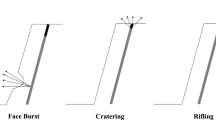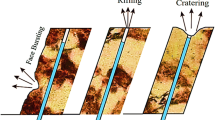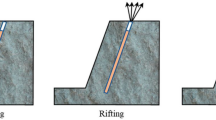Abstract
Drilling and blasting is a widely-used method for rock fragmentation in open-pit mines, tunneling and civil projects. Flyrock, as one of the most dangerous effects induced by blasting, can cause substantial damage to structures and injury to human. Therefore, the ability to make proper predictions of flyrock distance is important to reduce and minimize the environmental side effects caused by blasting operation. The main goal of the present research is to develop a precise equation for predicting flyrock through particle swarm optimization (PSO) approach. For comparison purpose, multiple linear regression (MLR) was also used. In this regard, a database including several controllable blasting parameters was collected from 76 blasting events in three quarry sites, Malaysia. In modeling procedures, five effective parameters on the flyrock including burden, spacing, stemming, powder factor and rock density were used as input parameters, while flyrock was considered as output parameter. In order to check the performance of the developed models, several statistical functions, i.e., root-mean-square error, Nash and Sutcliffe and coefficient of multiple determination (R 2), were computed. The results revealed that the proposed PSO equation is more reliable than MLR in predicting the flyrock. Based on sensitivity analysis results, it was also found that the RD was the most effective parameter on the flyrock in the studied cases.





Similar content being viewed by others
Explore related subjects
Discover the latest articles, news and stories from top researchers in related subjects.References
Singh TN, Verma AK (2010) Sensitivity of total charge and maximum charge per delay on ground vibration. Geomat Nat Hazards Risk 1(3):259–272
Verma AK, Singh TN (2009) A neuro-genetic approach for prediction of compressional wave velocity of rock and its sensitivity analysis. Int J Earth Sci Eng 2(2):81–94
Ghasemi E, Sari M, Ataei M (2012) Development of an empirical model for predicting the effects of controllable blasting parameters on flyrock distance in surface mines. Int J Rock Mech Min Sci 52:163–170
Verma AK, Singh TN (2013) Comparative study of cognitive systems for ground vibration measurements. Neural Comput Appl 22:341–1643
Monjezi M, Hasanipanah M, Khandelwal M (2013) Evaluation and prediction of blast-induced ground vibration at Shur River Dam, Iran, by artificial neural network. Neural Comput Appl 22:1637–1643
Monjezi M, Mehrdanesh A, Malek A, Khandelwal M (2013) Evaluation of effect of blast design parameters on flyrock using artificial neural networks. Neural Comput Appl 23:349–356
Dindarloo SR (2015) Peak particle velocity prediction using support vector machines: a surface blasting case study. J S Afr Inst Min Metall 115:637–643
Jahed Armaghani D, Hasanipanah M, Tonnizam Mohamad E (2015) A combination of the ICA-ANN model to predict air-overpressure resulting from blasting. Eng Comput. doi:10.1007/s00366-015-0408-z
Hasanipanah M, Jahed Armaghani D, Khamesi H, Bakhshandeh Amnieh H, Ghoraba S (2015) Several non-linear models in estimating air-overpressure resulting from mine blasting. Eng Comput. doi:10.1007/s00366-015-0425-y
Hasanipanah M, Monjezi M, Shahnazar A, Jahed Armaghanid D, Farazmand A (2015) Feasibility of indirect determination of blast induced ground vibration based on support vector machine. Measurement 75:289–297
Bhandari S (1997) Engineering rock blasting operations. Taylor & Francis, Boca Raton
Institute of Makers of Explosives (IME) (1997) Glossary of commercial explosive industry terms. Safety publication. Institute of Makers of Explosives, Washington DC, no 12, p 16
Bajpayee TS, Rehak TR, Mowrey GL, Ingram DK (2004) Blasting injuries in surface mining with emphasis on flyrock and blast area security. J Saf Res 35:47–57
Kecojevic V, Radomsky M (2005) Flyrock phenomena and area security in blasting-related accidents. Saf Sci 43:739–750
Roy PP (2005) Rock blasting effects and operations. Taylor & Francis, Boca Raton
Khandelwal M, Monjezi M (2013) Prediction of flyrock in open pit blasting operation using machine learning method. Int J Min Sci Technol 23:313–316
Raina AK, Murthy VMSR, Soni AK (2014) Flyrock in bench blasting: a comprehensive review. Bull Eng Geol Environ. doi:10.1007/s10064-014-0588-6
Fletcher LR, D’Andrea DV (1987) Reducing accident through improved blasting safety. USBM IC, 9135. In: Proceedings of bureau of mines technology transfer SEM. Chicago, pp 6–18
Mandal SK (1997) Causes of flyrock damages and its remedial measures. Course on: recent advances in blasting techniques in mining and construction projects, HRD-CMRI Dhanbad, pp 130–136
Adhikari GR (1999) Studies on flyrock at limestone quarries. Rock Mech Rock Eng 32:291–301
Lundborg N, Persson N, Ladegaard-Pedersen A, Holmberg R (1975) Keeping the lid on flyrock in open pit blasting. Eng Min J 176:95–100
Roth JA (1979) A model for the determination of flyrock range as a function of shot condition. US department of commerce. NTIS report no, PB81222358
Gupta RN (1980) Surface blasting and its impact on environment. In: Trivedy NJ, Singh BP (eds) Impact of mining on environment. Ashish Publishing House, New Delhi, pp 23–24
Trivedi R, Singh TN, Raina AK (2014) Prediction of blast induced flyrock in Indian limestone mines using neural networks. J Rock Mech Geotech Eng 6:447–454
Trivedi R, Singh TN, Gupta N (2015) Prediction of blast-induced flyrock in opencast mines using ANN and ANFIS. Geotech Geol Eng. doi:10.1007/s10706-015-9869-5
Marto A, Hajihassani M, Jahed Armaghani D, Tonnizam Mohamad E, Makhtar AM (2014) A novel approach for blast-induced flyrock prediction based on imperialist competitive algorithm and artificial neural network. Sci World J 2014(5):643715
Jahed Armaghani D, Hajihassani M, Mohamad ET, Marto A, Noorani SA (2014) Blasting-induced flyrock and ground vibration prediction through an expert artificial neural network based on particle swarm optimization. Arab J Geosci 7:5383–5396
Rezaei M, Monjezi M, Yazdian Varjani A (2011) Development of a fuzzy model to predict flyrock in surface mining. Saf Sci 49:298–305
Singh TN, Verma AK, Sharma PK (2007) A neuro-genetic approach for prediction of time dependent deformational characteristic of rock and its sensitivity analysis. Geotech Geol Eng 25(4):395–407
Khandelwal M, Kankar PK (2011) Prediction of blast-induced air overpressure using support vector machine. Arab J Geosci 4:427–433
Singh TN, Verma AK (2012) Comparative analysis of intelligent algorithms to correlate strength and petrographic properties of some schistose rocks. Eng Comput 28:1–12
Ghasemi E, Ataei M, Shahriar K (2014) Prediction of global stability in room and pillar coal mines. Nat Hazards 72:405–422
Ghasemi E, Ataei M, Shahriar K (2014) An intelligent approach to predict pillar sizing in designing room and pillar coal mines. Int J Rock Mech Min Sci 65:86–95
Verma AK (2014) A comparative study of various empirical methods to estimate the factor of safety of coal pillars. Am J Min Metall 2:17–22
Hasanipanah M, Shahnazar A, Bakhshandeh Amnieh H, Jahed Armaghani D (2016) Prediction of air-overpressure caused by mine blasting using a new hybrid PSO–SVR model. Eng Comput. doi:10.1007/s00366-016-0453-2
Amiri M, Bakhshandeh Amnieh H, Hasanipanah M, Khanli LM (2016) A new combination of artificial neural network and K-nearest neighbors models to predict blast-induced ground vibration and air-overpressure. Eng Comput. doi:10.1007/s00366-016-0442-5
Hasanipanah M, Noorian-Bidgoli M, Jahed Armaghani D, Khamesi H (2016) Feasibility of PSO-ANN model for predicting surface settlement caused by tunneling. Eng Comput. doi:10.1007/s00366-016-0447-0
Ghasemi E, Amini H, Ataei M, Khalokakaei R (2014) Application of artificial intelligence techniques for predicting the flyrock distance caused by blasting operation. Arab J Geosci 7:193–202
Monjezi M, Khoshalan HA, Varjani AY (2012) Prediction of flyrock and backbreak in open pit blasting operation: a neurogenetic approach. Arab J Geosci 5:441–448
Jahed Armaghani D, Mohamad ET, Hajihassani M, Abad SANK, Marto A, Moghaddam MR (2015) Evaluation and prediction of flyrock resulting from blasting operations using empirical and computational methods. Eng Comput. doi:10.1007/s00366-015-0402-5
Kennedy J, Eberhart RC (1995) Particle swarm optimization. In: Proceedings of IEEE international conference on neural networks, Piscataway, pp 1942–1948
Abdi MJ, Giveki D (2013) Automatic detection of erythemato-squamous diseases using PSO–SVM based on association rules. Eng Appl Artif Intel 26:603–608
Eberhart RC, Shi Y (2001) Particle swarm optimization: developments, applications and resources. In: Proceedings of IEEE international conference on evolutionary computation, pp 81–86
Zhang JR, Zhang J, Lok TM, Lyu MR (2007) A hybrid particle swarm optimization—back-propagation algorithm for feedforward neural network training. Appl Math Comput 185(2):1026–1037
Yagiz S, Karahan H (2011) Prediction of hard rock TBM penetration rate using particle swarm optimization. Int J Rock Mech Min Sci 48:427–433
Babanouri N, Karimi Nasab S, Sarafrazi S (2013) A hybrid particle swarm optimization and multi-layer perceptron algorithm for bivariate fractal analysis of rock fractures roughness. Int J Rock Mech Min Sci 60:66–74
Momeni E, Jahed Armaghani D, Hajihassani M, Amin MFM (2015) Prediction of uniaxial compressive strength of rock samples using hybrid particle swarm optimization-based artificial neural networks. Measurement 60:50–63
Gordan B, Jahed Armaghani D, Hajihassani M, Monjezi M (2015) Prediction of seismic slope stability through combination of particle swarm optimization and neural network. Eng Comput. doi:10.1007/s00366-015-0400-7
Ghasemi E (2016) Particle swarm optimization approach for forecasting backbreak induced by bench blasting. Neural Comput Appl. doi:10.1007/s00521-016-2182-2
Ghasemi E, Kalhori H, Bagherpour R (2016) A new hybrid ANFIS–PSO model for prediction of peak particle velocity due to bench blasting. Eng Comput. doi:10.1007/s00366-016-0438-121
Kalatehjari R, Ali N, Kholghifard M, Hajihassani M (2014) The effects of method of generating circular slip surfaces on determining the critical slip surface by particle swarm optimization. Arab J Geosci 7(4):1529–1539
Liang M, Tonnizam Mohamad E, Shirani Faradonbeh R, Jahed Armaghani D, Ghoraba S (2016) Rock strength assessment based on regression tree technique. Eng Comput. doi:10.1007/s00366-015-0429-7
Verma AK, Sirvaiya A (2016) Intelligent prediction of Langmuir isotherms of Gondwana coals in India. J Pet Explor Prod Technol 6:135–143
Esmaeili M, Osanloo M, Rashidinejad F, Aghajani Bazzazi A, Taji M (2014) Multiple regression, ANN and ANFIS models for prediction of backbreak in the open pit blasting. Eng Comput 30:549–558
SPSS Inc. (2007) SPSS for windows (version 16.0). SPSS Inc., Chicago
Yang Y, Zang O (1997) A hierarchical analysis for rock engineering using artificial neural networks. Rock Mech Rock Eng 30:207–222
Author information
Authors and Affiliations
Corresponding author
Ethics declarations
Conflict of interest
The authors declare no conflict of interest.
Rights and permissions
About this article
Cite this article
Hasanipanah, M., Jahed Armaghani, D., Bakhshandeh Amnieh, H. et al. Application of PSO to develop a powerful equation for prediction of flyrock due to blasting. Neural Comput & Applic 28 (Suppl 1), 1043–1050 (2017). https://doi.org/10.1007/s00521-016-2434-1
Received:
Accepted:
Published:
Issue Date:
DOI: https://doi.org/10.1007/s00521-016-2434-1




